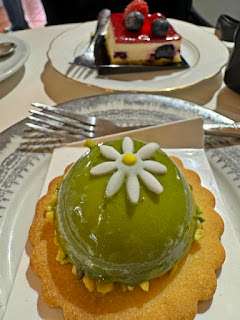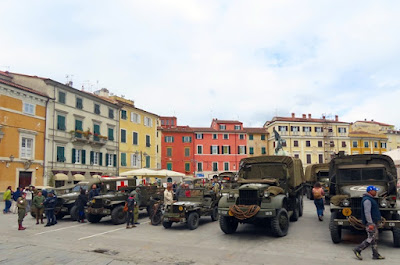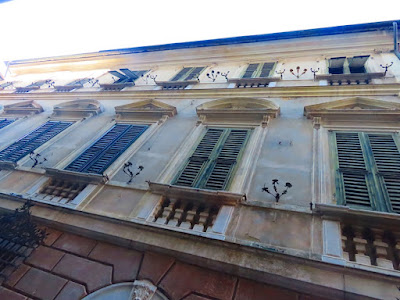Sarzana
Dominated by huge
fortresses and the oldest painted wooden cross in Italy, Sarzana is however
overlooked by tourists visiting Cinque Terre or Tuscany. It is an important
agricultural and commercial centre with an old town that’s full of character. Dated back to the 11th century,
Sarzana was built by people escaping the nearby marshes growing around the old
Roman town of Luni. Its ownership was fought between Pisa, Luca and Florence
until it was taken by Genoa in 1572.
*It marks a significant moment in the country’s history. This day commemorates the end of the Nazi occupation and fascist rule during World War II.
On this important public holiday, the Firmafede fortress (also called Cittadella), was also opened in the morning. It is an imposing defensive structure on the edge of the city walls within the historic center of Sarzana. The previous fortress, built by Pisans in the 13th century, was completely destroyed and rebuilt to the current form. The fortress was used as a police barracks, and until the end of the 1970s a prison.
Information at the internet mentioned that the MUdeF museum is housed within the fortress. However, it was closed during our visit.
 |
| View of Cittadella from Fortezza di Sarzanello |
The other fortress, Fortezza di Sarzanello (Fortress of Castruccio Castracani, named after the military leader from Lucca, lived at the manor only for about ten years, 1317- 1328) stands on the top of the Sarzanello hill overlooking the medieval city of Sarzana and the plain of the Val di Magra.
The walk from the town takes less than 20 minutes. Leave the historical town from Porta Romana, then turn left to Via S. Francesco and right to Via Fratta and walk further up to reach the Fortezza di Sarzanello. The climb is not difficult. It worths the effort to enjoy the panoramic views over Sarzana, valley and beautiful surroundings.
Back to the historical town, in the quiet part of Via Giuseppe Mazzini, stands the parish church of Sant' Andrea, the oldest religious building in the city. It experienced two massive renovations in 12th and 17th century. The baptismal font is a masterpiece made with Carrara marble by Giovanni Morelli at the late 16th century. There are some other admirable sculptures and art pieces.
The Romanesque-Gothic style Cathedral of Santa Maria Assunta is right at the middle of the original town centre. It was rebuilt over the Gothic church of San Basilio in 1474 and retains the older tower. There's a fine 14th-century door and elaborate carved wooden ceiling by Pietro Giambelli between 1662 and 1670.
The Cross of
Maestro Guglielmo (in English: Master William) in the Cathedral of Sarzana (1138)
serves as the oldest extant example of a monumental painted panel cross. Jesus
is not presented with sufferings but a serene face and wide-opened eyes, a
symbol of Christ in triumph and alive. Prepare a small donation to get the art
illuminated.
Walk around the interior of the cathedral to appreciate various art pieces.
A nice surprise when we stepped out of the cathedral: a parade of war vehicles carrying different types of soldiers was passing through. Countless and various types of vehicles showcased at the Matteotti Square. An ambulance vehicle stood somewhere with patients and first aid stuff lying on the floor. At another corner, soldiers were holding their food box/trays and lining up for soup and sandwiches, a memory of the war.
Still other surprises and delights: Teatro degli Impavidi, Museo Diocesano and various palazzos opened their doors to welcome the locals and visitors. Everywhere was full of people, to celebrate and rejoice.
Teatro degli Impavidi brightened our eyes with its velvet red, elegant and beautiful set up.
Walking along the main street, Via Giuseppe
Mazzini, various palaces showcased eternal film stars and renowned films. A
model and video of Marilyn Monroe was shown in the Tusini Palace. Vivid and
joyful atmosphere filled the elegant space. Neoclassical style frescoes on the
ceiling and walls are beautiful. A statue of Bacchus appreciating grapes stands
next to a marble staircase.
Then we were attracted to gorgeous costumes with florals at the front door of the Magni Griffi Palace. This is a building of Renaissance origins, but the present appearance dates from the 18th century. A monumental staircase supported by mighty marble columns won many attractions. Visitors were allowed to visit the atrium. A marble basin with mascaron was along the way. Not sure if it is still used for collecting rainwater or has changed to the modern version. A tree, as tall as the building, stood at the middle of the atrium and provided shade.
Back to the living room, display of the film ‘Gone with the Wind’ set in. The kiss between Scarlett O'Hara (VivienLeigh) and Rhett Butler (Clark Gable) is ever-lasting and romantic.
A friend was driving from Milan to
pick us up for the next days’ trip. We could only managed to visit the above
three palazzos. Not sure what will pop up next year. I wish I would be there
again. Who knows?



































Comments